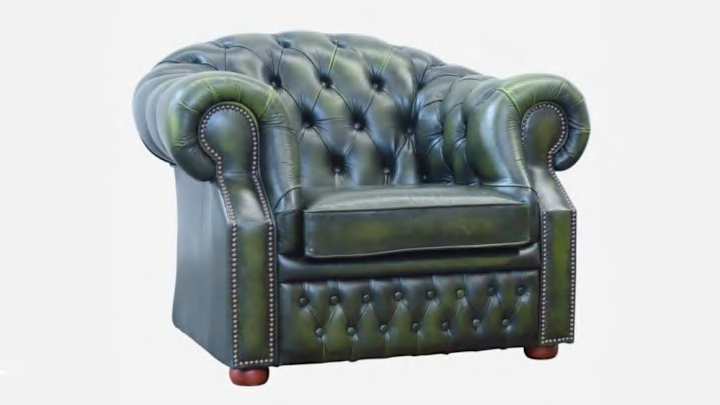Chair: 500 Designs That Matterwill teach you more than you ever thought you'd know about sitting down.
When we think about chairs, it’s usually in terms of how comfortable they are, whether they’ll fit in our homes, and whether we think they’re pretty—not about how a particular chair came to be. Chairs come from IKEA, or maybe West Elm, right? But someone had to come up with the familiar chair designs we see in homes, offices, stores, and backyards around the world.
Chair: 500 Designs That Matter, a new book from Phaidon, is a hefty compendium of some of the most innovative and well-known chairs dating back to 1000 CE. “The chair is central to our way of living and working, and each of the 500 chairs in this book (together with the designers behind the creations) has in no small part changed the way that we all live,” as the book’s introduction puts it. Here are six of their origin stories.
1. CHESTERFIELD ARMCHAIR // 1700s

“Chairs are integral to every aspect of modern life—we use them when we eat, write, read, work, rest, when we converse and even when we sleep," the editors at Phaidon write. "It can be inexpensive or expensive to buy, industrially manufactured or hand crafted, produced in millions or as an artisanal one-off. The possibilities are infinite, and the number of chairs designed and produced since the chair became an everyday object is also beyond number.”
The Chesterfield armchair dates all the way back to the 1700s, when, legend has it, British writer and politician Philip Stanhope, the Earl of Chesterfield, wanted to be able to sit down comfortably without creasing his clothing. The Chesterfield armchair, with its low back, rolled arms, and nail-head trim was the eventual result. "Whatever the truth, by the 1800s, Chesterfield was synonymous with a leather armchair," according to the book, and could be found in libraries and gentlemen's clubs around the world.
2. FAN-BACK SIDE CHAIR // c. 1780

Fan-back Windsor chairs like this one were first introduced to America by 18th century English settlers, and the first U.S. versions were probably produced in Pennsylvania. The chairs were relatively cheap, stylish, and in high demand in the late 1700s. Because demand for Windsor chairs was so strong, the design evolved to be very simple, eschewing decorative touches so that the chairs could be produced faster.
3. GARDEN CHAIR // 1900s

Now a ubiquitous presence at parks and outdoor events, this simple folding chair first appeared in Paris in the early 20th century. We don't know who first designed it, but its slight metal frame and simple pivot mechanism made it lighter and smaller than earlier, all-wooden folding chairs. "The design is flawless," the editors of Chair rave, "as is proved by its adoption as the archetypical outdoor chair with its understated style and highly practical design."
4. GACELA CHAIR // 1978

"No chair is more representative of modern cafe culture than the Gacela Chair," the Phaidon editors write. Created by Spanish designer Joan Casas i Ortinez in 1978, it was designed as part of a whole collection of stacking chairs, but the Gacela stands out. Made from anodized aluminum tubes, it's lightweight, durable, and easy to stack, with a simple, clean look, making it a popular choice for both indoor and outdoor cafe use.
5. AMERICAN LAWN CHAIR // 1940s

The first of these quintessential folding chairs was made in 1947 by the Frederic Arnold Company in Brooklyn. Since then, it has become a classic staple for backyard barbecues, Fourth of July firework spectaculars, and tailgating, among other uses. The fabric seat of the original 1947 version has been replaced by synthetic webbing and the armrests now often include cupholders, but the basic flat-folding, aluminum construction has stayed the same.
6. POLYPROPYLENE STACKING CHAIR // 1963

"The familiar form of Robin Day's Polypropylene Stacking Chair belies its significance in the history of furniture design," the Phaidon editors note. "The simple shape of the single-piece shell with deep-turned edge and finely textured surface affixed to a stacking base, remains the most democratic seating design of the 20th century." It all comes down to the plastic. It was the first chair made of injection-molded polypropylene, a material that had been invented only a decade earlier. The cheap, durable, mass-produced chair is now considered one of the best-selling chairs in the world and a classic of British design (it's even been on a postage stamp). Around 14 million of them have been sold in 23 countries. And that's not even counting the knock-offs.

To read more about the history of seating, you can buy Chair: 500 Designs That Matter for $19 on Amazon.
